The post 9 Beautiful and Rare Species Found Only in Australia appeared first on TheAussieway.
]]>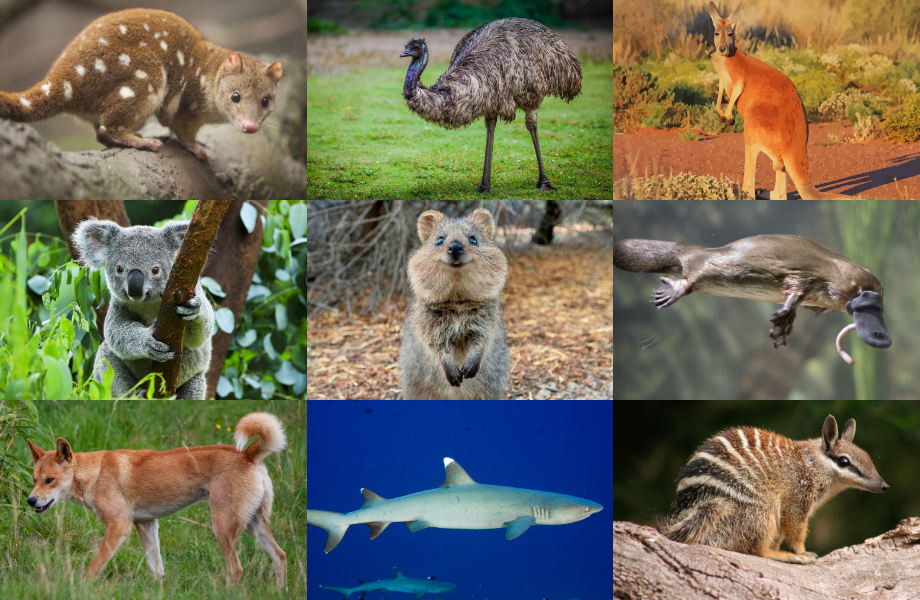
The supercontinent of Gondwana split 180 million years ago. What would become Australia and Antarctica was part of a breakaway landmass from that breakup. Australia had completely separated by the time it travelled north on its own 30 million years ago. Since then, modifications to the land’s climate and physical isolation from the rest of the world have contributed to the development of different unique Australian species. Australia is the only place in the world where more than 80% of our flora, animals, reptiles, and frogs can be found.
About one million different native animal species can be found in Australia.
More than 80% of the country’s mammals, reptiles, and frogs, as well as the majority of its freshwater fish and 70% of its bird species, are exclusive to the Australian natural environment.
140 species of marsupials, such as kangaroos, wallabies, koalas, wombats, and the Tasmanian Devil, which is currently only found in Tasmania, and is one of the rare species in Australia. The dingo is the largest carnivorous mammal native to Australia and a wild dog.
About half of the 828 bird species found in Australia are unique to the country, with the huge, nearly two-meter-tall flightless emu being the most well-known.
Waterbirds, seabirds, and birds that live in open woodlands and forests all abound in Australia, including black swans, fairy penguins, kookaburras, and lyrebirds. Australia is home to 55 different species of colourful parrots, as well as a stunning array of cockatoos, rosellas, lorikeets, parakeets, and budgerigars.
More poisonous snake species, namely 21 of the 25 deadliest species, as well as two types of crocodiles, one saltwater and one freshwater, may be found in Australia than on any other continent.
The UNESCO World Heritage-listed Great Barrier Reef, which is the biggest coral reef system in the world, is also located in Australia. With our Exploring Our Ocean course, you may learn more about marine environments.
The predatory great white shark, which can reach a length of six metres, the enormous whale shark, which can grow to a length of 12 metres, and the box jellyfish, one of the world’s most venomous creatures are among the distinctive marine species.
Kangaroos, dingos, wallabies, wombats, and, of course, koalas, platypus, and echidnas are just a few of the well-known Australian wildlife. However, there is still a great deal that is unknown about the native creatures of Australia. In this article, we’ll look at 9 of the most unique animal species that are considered rare species in Australia.
Why are Australian animals so unique?
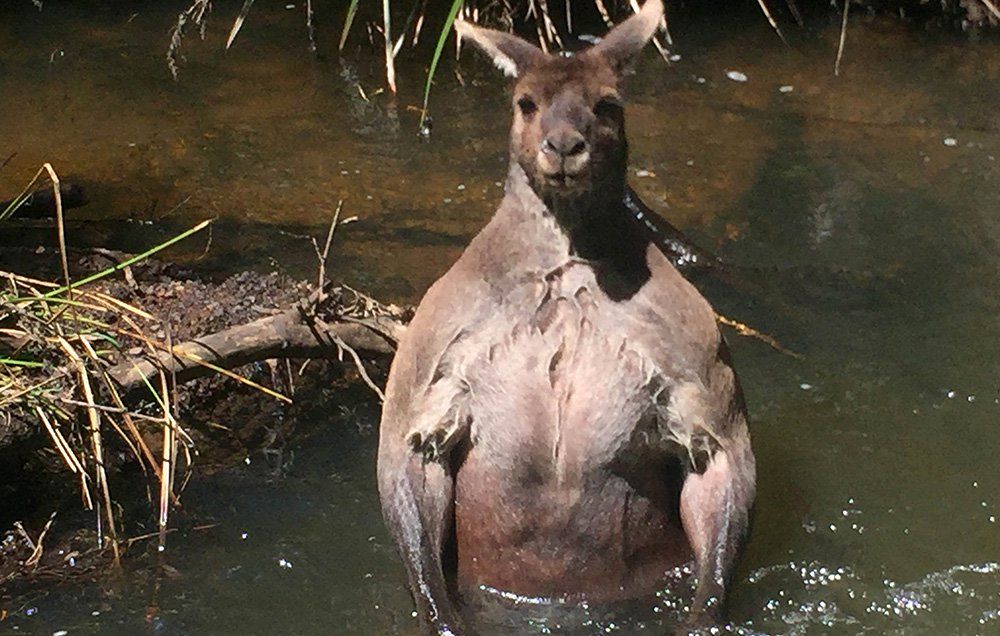
Since Australia is geographically isolated in the southern hemisphere and is known as “The Land Down Under,” many of its animals are unique to Australia.
Around 250 million years ago, the Earth consisted of simply one enormous supercontinent called Pangaea, according to evolutionary history and fossil evidence.
After around 50 million years, this supercontinent split into the continents Laurasia and Gondwana. Monotremes and marsupials dominated the region of tropical forests in Gondwana at the time of this split, whereas placental mammals originated in Laurasia.
After thereafter, in the Jurassic Period, 180 million years ago, the western part of Gondwana, which comprised Africa and South America, split off from the eastern half, which contained Madagascar, India, Australia, and Antarctica. 40 million years later, India gradually broke away from Australia and Antarctica, forming the Indian Ocean. Australia and Antarctica slowly drifted to the south, where they were surrounded by immense oceans and cut off from the rest of the world.
Australia and Antarctica ultimately split apart 50 million years ago. Its environment changed as it moved away from the southern arctic zone, becoming warmer and dryer, and new animal species emerged and took over the landscape.
Eventually, monotremes and marsupials took over as the main mammals in Australia due to their less demanding reproductive systems and greater suitability for this new climate.
The original inhabitants of the Australian landmass no longer interacted with species from other continents, thus they continued to develop on their own. Australian native animals are distinctive from those found elsewhere in the globe because of their distinct evolution, which has produced several odd Australian animals.
Australia is home to some of the most unique species on Earth due to its geographic isolation, diverse ecosystems, and evolutionary history. Separated from other continents for millions of years, Australia developed a vast array of flora and fauna found nowhere else. Around 80% of its mammals, reptiles, and amphibians are endemic, meaning they exist only in Australia.
One of the main reasons for this incredible biodiversity is the variety of habitats, ranging from rainforests and deserts to coastal regions and mountains. These environments have allowed Australian native animals to adapt in extraordinary ways. The platypus, for example, is a monotreme, meaning it lays eggs despite being a mammal. Kangaroos, koalas, and echidnas are also unique to the continent, showcasing Australia’s remarkable wildlife.
Unfortunately, human activities, habitat destruction, climate change, and the introduction of invasive species have put many animals at risk. Some Australian animals that are endangered include the Tasmanian devil, the northern hairy-nosed wombat, and the orange-bellied parrot. Conservation efforts aim to protect these species through habitat preservation and breeding programs.
Additionally, there are several Australian protected species, including the numbat and the Gouldian finch, which are safeguarded under conservation laws. National parks, wildlife reserves, and strict environmental policies play a crucial role in preventing further decline.
Despite these efforts, some animals have already been lost. The thylacine, or Tasmanian tiger, is one of the most well-known Australian extinct animals, having disappeared in the 20th century due to hunting and habitat loss.
Let’s explore some of Australia’s most unique species to create awareness.
Fitzroy River Turtle
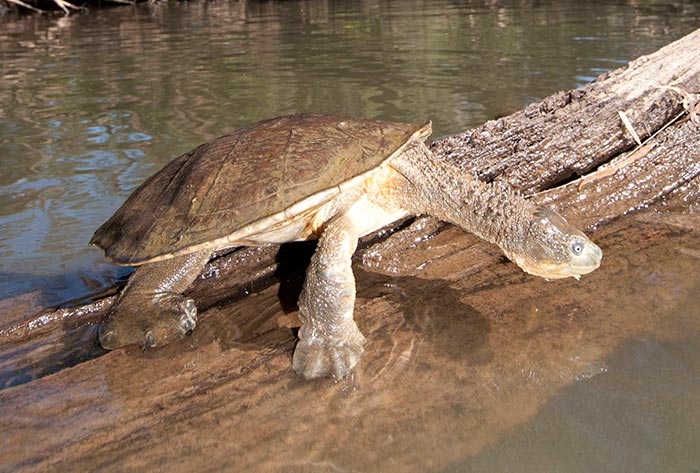
Rheodytes leukops, a species of turtle from the Rheodytes genus, live in the Fitzroy River. The other species in that genus, Rheogytes devisi are some Australian extinct animals, leaving only them as the remaining species. In Queensland, Australia’s Fitzroy River and its tributaries are where you can find them.
Fitzroy River turtles spend roughly 21 days submerged. They are remarkably adaptable creatures. The other species of their genus are extinct, leaving only these critters as survivors. The extinct species was known by the name “Rheodytes devisi”. September to October is the time when they lay their eggs.
These turtles are classified as Vulnerable species on the IUCN Red List. Because of habitat degradation, predators, and population decrease, they are classified as Vulnerable by IUCN. These turtles are frequently attacked, along with their nests, by foxes, pigs, and goannas.
Because predators frequently attack and totally destroy their nest, there are no surviving hatchlings left, which is a major factor in their Vulnerable conservation status. Its population growth is challenging for this species because of this.
To get the most out of their toe daggers, cassowaries can jump feet first, so their claws can slash downward in mid-air towards their target.
Australian Southern Cassowary
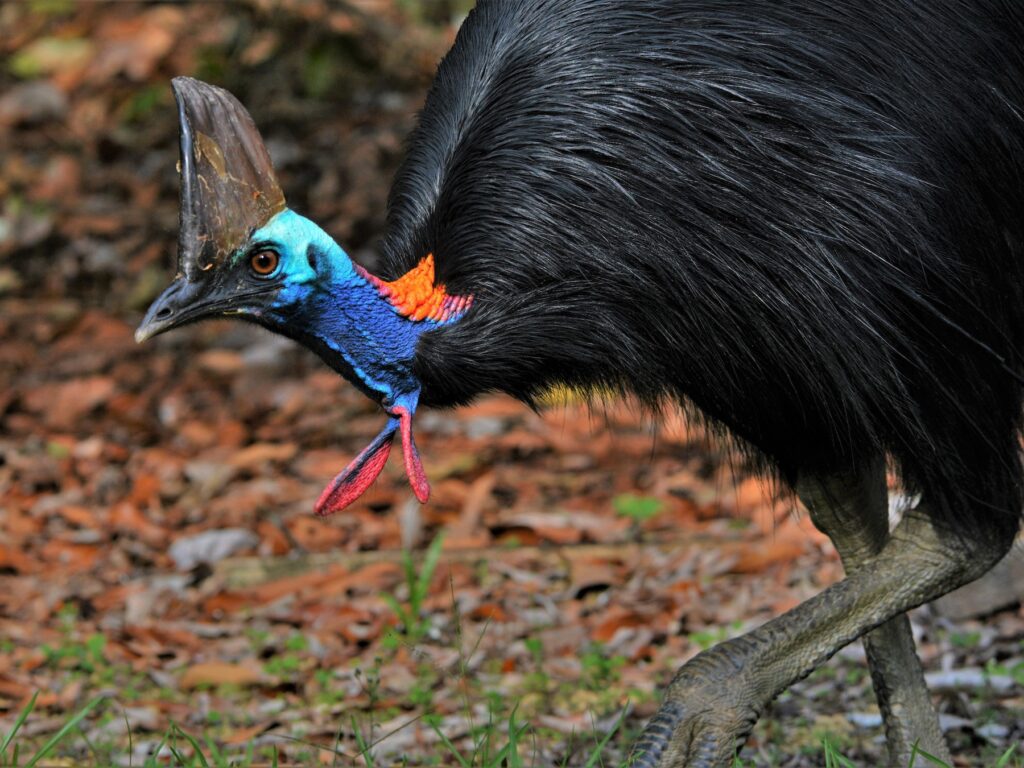
This bird, which descended from dinosaurs, has been designated as the “most hazardous bird on Earth.” Most human attacks in which victims are kicked, shoved, jumped on, and headbutted are motivated by the need to provide food for the bird. Their 12-centimetre middle claw functions as a dagger and may cause significant harm.
Be on the lookout for the elusive cassowary if you happen to be in Tropical North Queensland. It’s a big, colourful bird that has a prehistoric appearance if that answers your question. The cassowary may reach a height of 180 cm and often weighs 60 kg. With its distinctive appearance, the cassowary is simple to identify. Especially its blue neck and the helmet-shaped protrusion on its head.
They’re great sprinters too, with a top running speed of 50 km/h through dense forest. Not only that, they’re good swimmers, with the ability to cross wide rivers and swim in the sea. That’s one animal you don’t want to be chased by!
Saltwater Crocodile
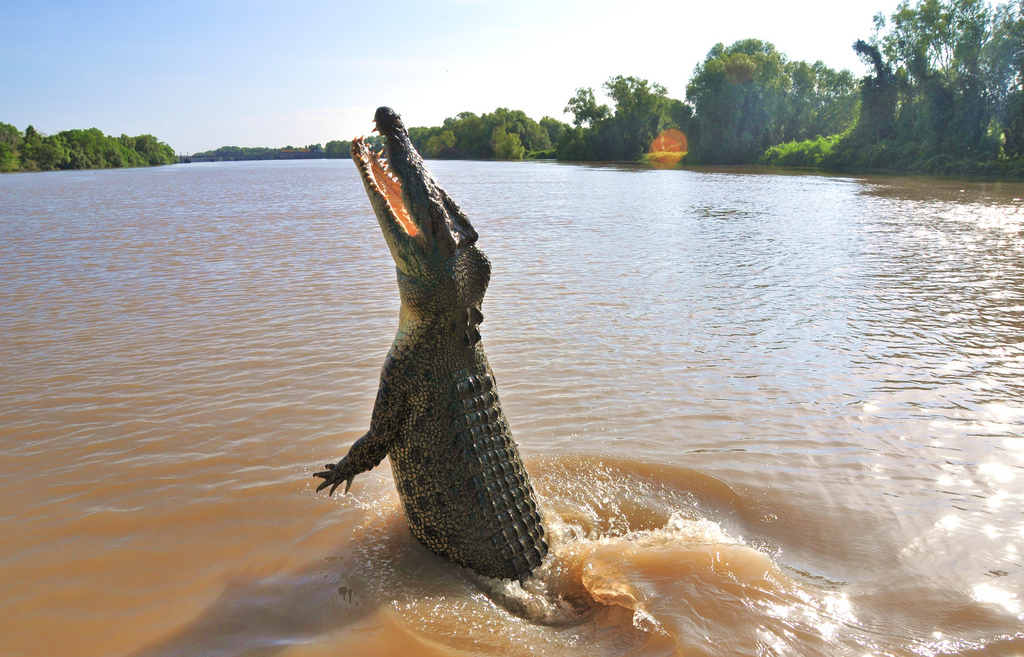
It is the largest reptile in the world, with a known maximum weight of over 1000 kg, and has the strongest bite of any species. Sadly this is one of the beautiful Australian animals that are endangered. This endangered species mostly consume small reptiles, turtles, fish, wading birds, wild pigs, and livestock including cattle and horses.
Did you know? A crocodile cannot sweat, so instead, it relies on the process of thermoregulation to control its body temperature. To avoid overheating, it will either go into the water or lie still with jaws agape, allowing cool air to circulate over the skin in its mouth. That’s why you often see them happily basking in the sun with their mouths wide open. This process is crucial for many bodily functions including digestion and movement.
Mistletoebird
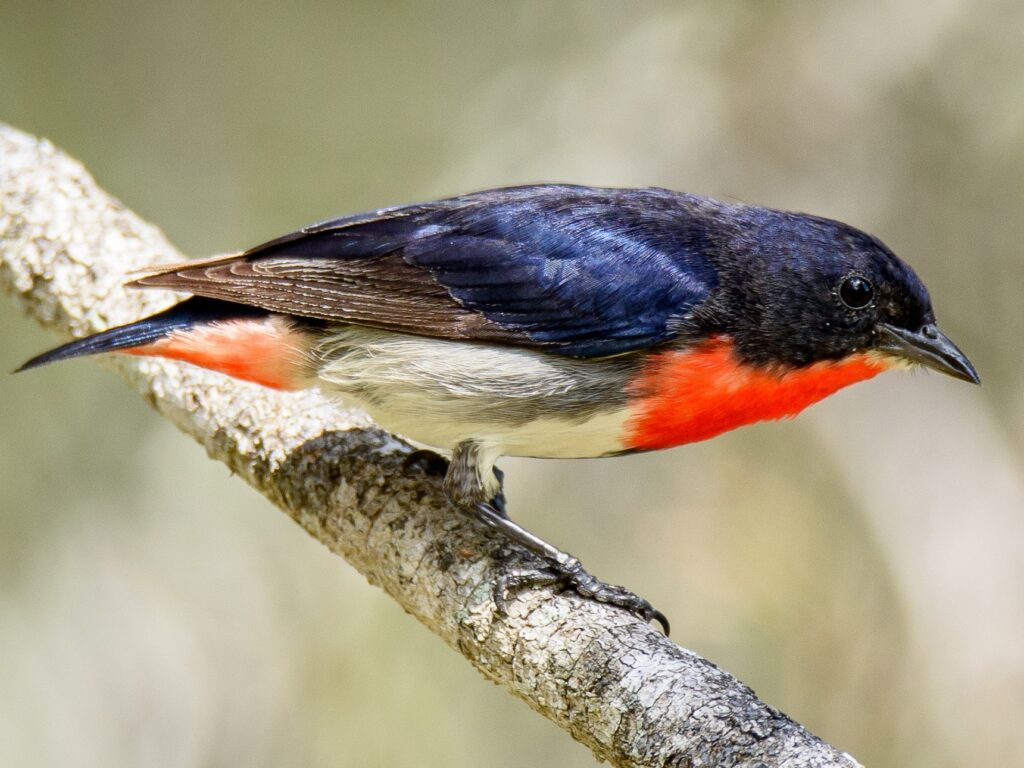
The little Mistletoebird, often called the Australian Flowerpecker, is the sole member of the Dicaeidae family of flowerpeckers that lives in Australia. Males have a bright red throat and chest, a white belly with a central dark streak, and a bright red undertail in addition to having a glossy blue-black head, wings, and upperparts. Females have a pale crimson undertail and a belly streaked with the grey that is white above. Young birds are female-like, but whiter and with an orange-coloured bill as opposed to a dark one. These birds fly quickly and erratically, alone or in couples, typically high in or above the canopy.
To its diet of mistletoe berries, the mistletoebird has developed a strong adaptation. The rudimentary digestive system it has allows it to quickly process the berries, breaking down the fleshy outer sections and excreting the sticky seeds onto branches. It lacks the muscular gizzard (food-grinding organ) of other birds. After then, the seed might quickly grow into a new plant. The mistletoebird does this to guarantee a steady supply of its primary meal. In order to feed its young, it will also catch insects.
The mistletoebird is widespread over mainland Australia and can be found wherever mistletoe is present. It plays a significant role in the spread of this plant species. Eastern Indonesia and Papua New Guinea also contain it.
Tasmanian Devil
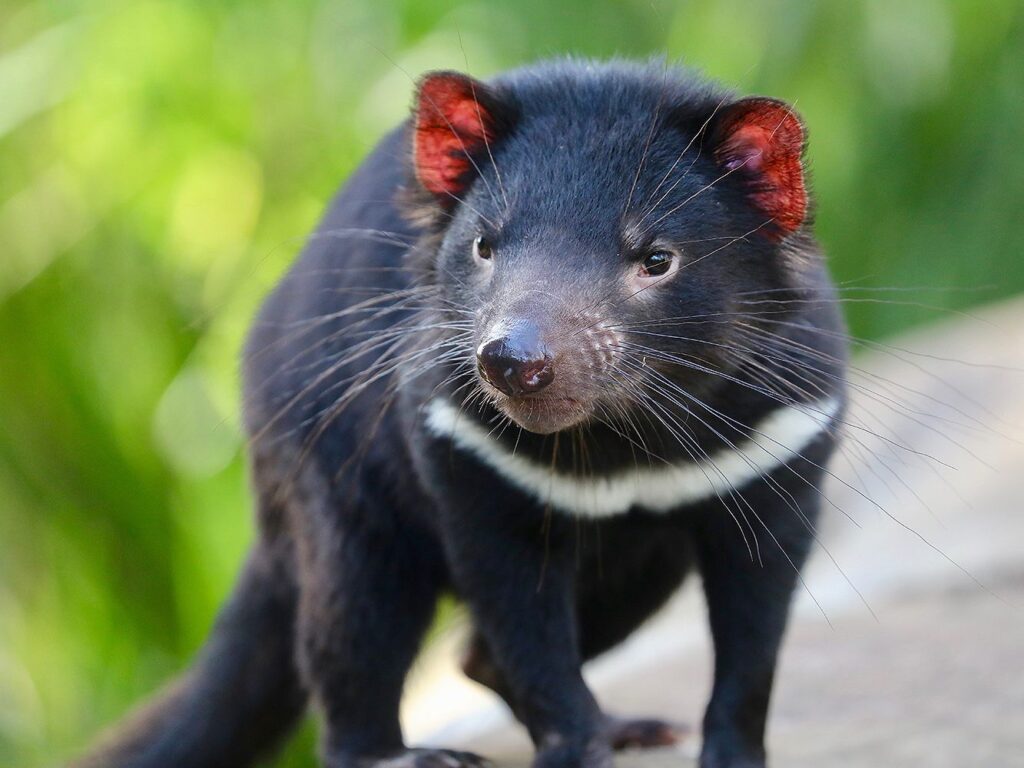
The Tasmanian Devil is listed as an endangered species in Australia. Their tail, where they store fat, may hold up to 40% of their body weight per day, thus you can gauge their health by the size of it! Although they don’t have the same terrifying appearance as other creatures in Australia, they have a bite that is so strong that it may easily break bones.
These creatures are worth viewing, despite the fact that some people may find them cute and others may find them horrifying. It is a carnivore that can only be found in the woods of Australia. The intriguing thing about its name is that these creatures were discovered in Tasmania for the first time, and due to their obnoxious yells and frightful growls, people thought they were quite diabolical. It is also known as Tasmanian Devils. In Australia, don’t miss viewing these adorable devils.
While travelling through Tasmania, you have the best chance of seeing Tasmanian devils in the wild. At Cradle Mountain-Lake St. Clair National Park, Devils Cradle, and Tasmanian Devil Unzoo, which offers a 4WD tour on which you may follow the devil’s movements, you can get up close and personal with these wild animals. There are other zoos and sanctuaries all around the country.
Echidna

Echidnas are spiny anteaters, one of the egg-laying mammals, and among the most endangered species on the planet. One of the remaining monotreme species, the echidna has a sharp spine like a large porcupine.
Despite having a similar (but smaller) look and diet to the anteater, the Echidna, sometimes known as the spiky anteater, is not actually related to it. Termites and ants make up its food. It belongs to the monotreme order of egg-laying animals and is also a very good swimmer. With the help of its powerful and sturdy legs, the echidna can dig burrows for protection, or it can curl up into a ball and project its spines outward to scare off potential predators. But it’s still adorable!
There are four species of echidnas, including the Short-beaked Echidna found throughout Australia in places like the Great Western Woodlands.
Kookaburra

The social kookaburra is well recognised for its characteristic chuckle. In the majority of Australian woods, you can spot or hear them. The distinctive laugh-like call of these cold Australian birds makes them well-known. Additionally, they have enormous bills, which make it easy for them to swoop down from the treetops and capture their prey.
However, researchers have discovered that family members laugh similarly to one another. The kookaburra doesn’t laugh if it is kept in captivity alone because laughing is a social behaviour.
Australian Reptile Park or Featherdale Wildlife Park in NSW; Magnetic Island National Park; Taronga Zoo in Sydney; Kangaroo Island in South Australia; Australia Zoo in NSW; Australian Reptile Park in NSW; and Australia Zoo in NSW are some of the top tourist destinations throughout the country. Kookaburras can claim large trees as their own in all settings.
Numbat
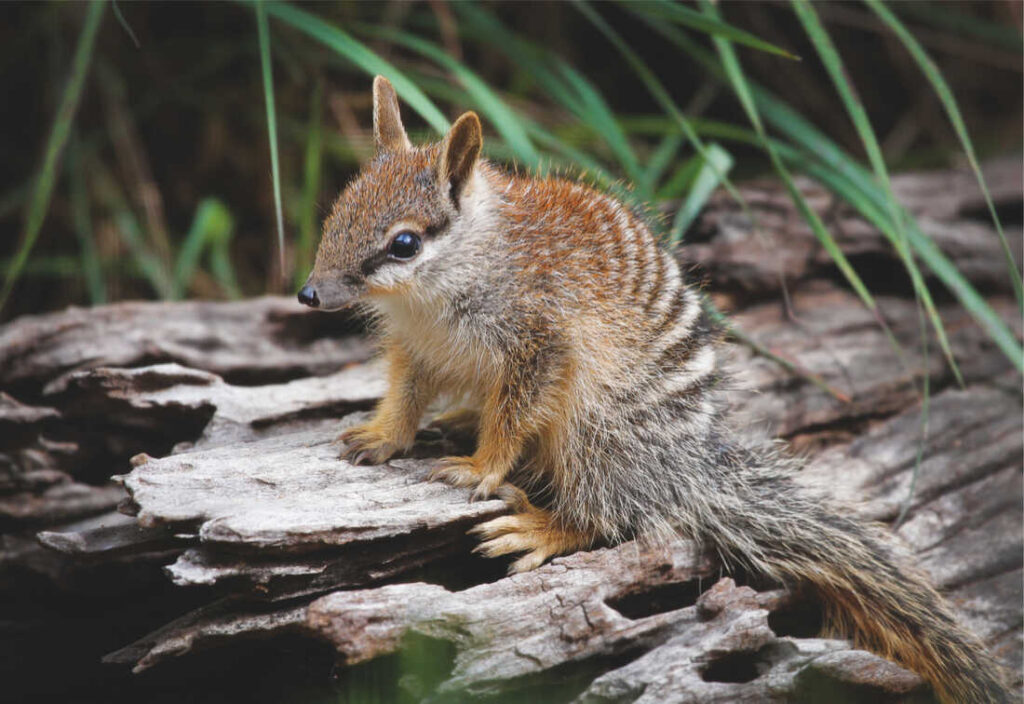
The Numbat is an Australian protected species that is a small marsupial that survives in southwest Western Australia. Due to its small size, the Numbat is hunted by many animals like feral cats, foxes, dingoes and birds of prey. Because it is solely on termites which are active by day, the Numbat is the only diurnal (opposite of nocturnal) marsupial.
Using its 4-inch tongue, the Numbat only consumes termites. These territorial, lonely Australian critters travel great distances to get food. They don’t require water, like other species of the Australian desert. The moisture they need comes from the termites they eat.
It spends nights hiding in hollow logs or burrows that are too narrow for its predators to enter. To further protect itself from predators at night, it uses its very thick-skinned rump to block the entrance. Now that’s using your behind to get ahead.
Pellucid Hawk Moth
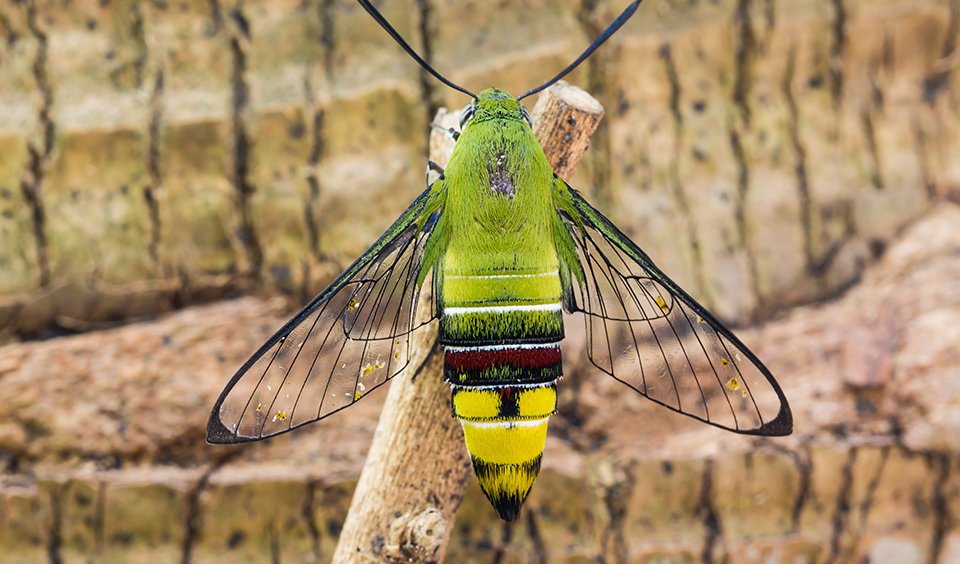
The Pellucid Hawk Moth looks partly moth, partly cicada, and partly Glasswing Butterfly. According to Australian Geographic, very few species of Lepidoptera, the insect order which includes all butterflies and moths, have scaleless, transparent wings.
Coloured wings can serve many functions, including communication, defence, thermoregulation, feeding, and waterproofing. So why the transparent wings? It’s thought these wings reflect about 50% less light than opaque ones, rendering the wings almost invisible in flight. It’s like an invisibility cloak which makes it a great defence against becoming prey.
Closing Words
The climate and huge terrain of Australia are as distinctive as the animals that inhabit it. And despite Australia’s abundance of lethal and dangerous creatures, you shouldn’t worry about them because everything has been done to ensure that everyone is safe.
Climate change and the effects of land clearing, which are tragically affecting Australia’s animals, should be our top priorities when it comes to conserving these species.
According to research, up to 33% and 56% of already categorized as endangered species of Australia, and they are at risk from urban growth and climate change, respectively. Building a sustainable future is therefore more crucial than ever.
You can help maintain the natural ecosystem not just in Australia but all over the world by identifying tiny methods to reduce climate change and global warming.
The post 9 Beautiful and Rare Species Found Only in Australia appeared first on TheAussieway.
]]>